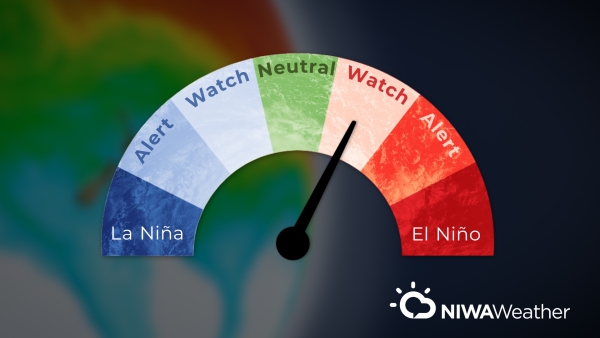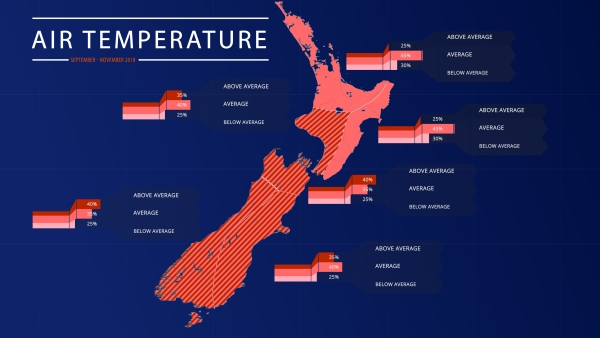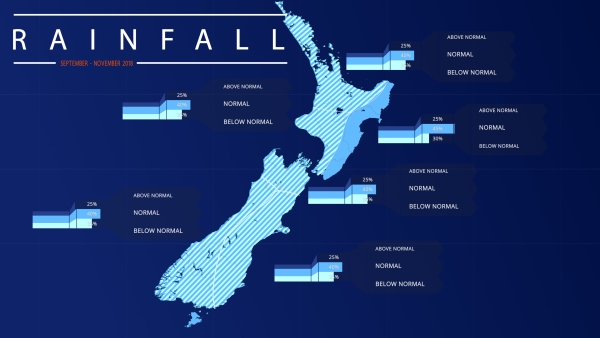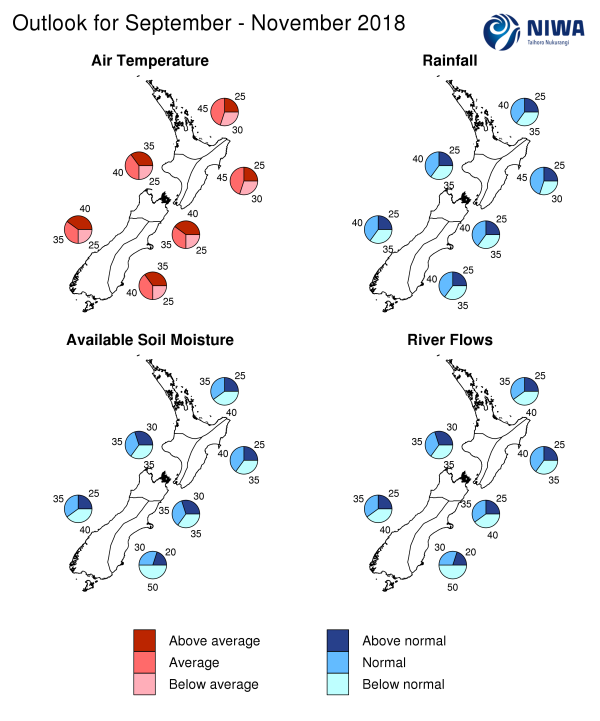Overview
For the fifth consecutive month, ENSO-neutral conditions persisted across the tropical Pacific. During August 2018, the Southern Oscillation Index (SOI) trended negative and had a preliminary value of -0.9 (on the El Niño side). Sea surface temperatures (SSTs) in the west-central equatorial Pacific warmed once again and the NINO4 Index had a preliminary anomaly of +0.61°C (on the El Niño side of neutral).
The consensus from international models is for the tropical Pacific to transition toward El Niño over the next three-month period (65% chance over September – November 2018). The probability for El Niño conditions being established increases as we reach into and beyond the Southern Hemisphere summer, with a 78% chance for El Niño conditions over the March – May 2019 period. Indications are that the event – if it eventuates – will not be in the strong category. The type appears to lean toward the central Pacific event, although dynamical models indicate that warm SST anomalies may gradually transit eastward later in 2018 into early 2019.
In other words, the upcoming El Niño event, should it come to fruition, is not expected to be of a similar intensity to what was experienced during 2015-16, 1997-98, or 1982-83 and therefore different impacts are expected.
The September – November 2018 atmospheric circulation around New Zealand is forecast to be characterized by higher pressure than normal over the South Island and to the south and west of the country and lower than normal pressure to the northeast of New Zealand, leading to anomalous easterly quarter (southeast to northeast) air flows over New Zealand. This deviates from the enhanced southwesterly air flow pattern typically experienced during traditional El Niño events. The circulation pattern may be associated with cold nights and mornings, as well as frosts and fog, especially early in the spring season. However, SSTs warmed around New Zealand during the month of August. These warmer seas may help to lessen the sting of colder airmasses as they push toward New Zealand during the spring season.
Outlook Summary
September – November 2018 temperatures are forecast to be average (35 – 40% chance) or above average (35 – 40% chance) for all regions of New Zealand except the north and east of the North Island, where near average temperatures are most likely (45% chance).
September – November 2018 rainfall totals are forecast to near normal (40% chance) or below normal (35% chance) for all regions of New Zealand except the east of the North Island, where near normal rainfall is most likely (45% chance).
September – November 2018 soil moisture levels and river flows are forecast to be near normal (35-40% chance) or below normal (35-40% chance) for all regions of New Zealand except for the east of the South Island, where below normal soil moisture levels and river flows are expected (50% chance).
Regional predictions for the September – November 2018 season
Northland, Auckland, Waikato, Bay of Plenty
The table below shows the probabilities (or percent chances) for each of three categories: above average, near average, and below average. In the absence of any forecast guidance there would be an equal likelihood (33% chance) of the outcome being in any one of the three categories. Forecast information from local and global guidance models is used to indicate the deviation from equal chance expected for the coming three-month period, with the following outcomes the most likely (but not certain) for this region:
- Temperatures are most likely to be near average (45% chance).
- Rainfall totals, soil moisture levels and river flows are all about equally likely to be near normal (35 – 40% chance) or below normal (35 – 40% chance).
The full probability breakdown is:
|
Temperature |
Rainfall |
Soil moisture |
River flows |
|
|
Above average |
25 |
25 |
25 |
25 |
|
Near average |
45 |
40 |
35 |
35 |
|
Below average |
30 |
35 |
40 |
40 |
Central North Island, Taranaki, Whanganui, Manawatu, Wellington
Probabilities are assigned in three categories: above average, near average, and below average.
- Temperatures are about equally likely to be near average (40% chance) or above average (35% chance).
- Rainfall totals are about equally likely to be near normal (40% chance) or below normal (35% chance).
- Soil moisture levels and river flows are equally likely to be in the near normal (35% chance) or below normal range (35% chance).
The full probability breakdown is:
|
Temperature |
Rainfall |
Soil moisture |
River flows |
|
|
Above average |
35 |
25 |
30 |
30 |
|
Near average |
40 |
40 |
35 |
35 |
|
Below average |
25 |
35 |
35 |
35 |
Gisborne, Hawke’s Bay, Wairarapa
Probabilities are assigned in three categories: above average, near average, and below average.
- Temperatures are most likely to be near average (45% chance).
- Rainfall totals are most likely to be near normal (45% chance).
- Soil moisture levels and river flows are about equally likely to be in the near normal (40% chance) or below normal range (35% chance).
The full probability breakdown is:
|
Temperature |
Rainfall |
Soil moisture |
River flows |
|
|
Above average |
25 |
25 |
25 |
25 |
|
Near average |
45 |
45 |
40 |
40 |
|
Below average |
30 |
30 |
35 |
35 |
Tasman, Nelson, Marlborough, Buller
Probabilities are assigned in three categories: above average, near average, and below average.
- Temperatures are about equally likely to be above average (40% chance) or near average (35%).
- Rainfall totals and river flows are about equally likely to be near normal (35 – 40% chance) or below normal (35 – 40% chance).
- Soil moisture levels are equally likely to be in the near normal (35% chance) or below normal range (35% chance).
The full probability breakdown is:
|
Temperature |
Rainfall |
Soil moisture |
River flows |
|
|
Above average |
40 |
25 |
30 |
25 |
|
Near average |
35 |
40 |
35 |
35 |
|
Below average |
25 |
35 |
35 |
40 |
West Coast, Alps and foothills, inland Otago, Southland
Probabilities are assigned in three categories: above average, near average, and below average.
- Temperatures are about equally likely to be above average (40% chance) or near average (35% chance).
- Rainfall totals, soil moisture levels and river flows are all about equally likely to be near normal (35 – 40% chance) or below normal (35 – 40% chance).
The full probability breakdown is:
|
Temperature |
Rainfall |
Soil moisture |
River flows |
|
|
Above average |
40 |
25 |
25 |
25 |
|
Near average |
35 |
40 |
35 |
35 |
|
Below average |
25 |
35 |
40 |
40 |
Coastal Canterbury, east Otago
Probabilities are assigned in three categories: above average, near average, and below average.
- Temperatures are about equally likely to be near average (40% chance) or above average (35% chance).
- Rainfall totals are about equally likely to be near normal (40% chance) or below normal (35% chance).
- Soil moisture levels and river flows are most likely to be below normal (50% chance).
The full probability breakdown is:
|
Temperature |
Rainfall |
Soil moisture |
River flows |
|
|
Above average |
35 |
25 |
20 |
20 |
|
Near average |
40 |
40 |
30 |
30 |
|
Below average |
25 |
35 |
50 |
50 |
Graphical representation of the regional probabilities
Background
The Southern Oscillation Index (SOI) was negative (i.e. on the El Niño side) with a preliminary value of -0.9 for August 2018.
Sea surface temperatures (SSTs) in the vicinity of the Dateline continued to warm during August 2018. Preliminarily, the NINO4 Index is now on the El Niño side of neutral at +0.61°C (was +0.45°C last month) but the NINO3.4 Index remained in the neutral range at +0.28°C (was +0.47°C last month).
The monthly NINO3 index was also in the neutral range on +0.15°C (+0.52°C last month), and the monthly NINO1+2 Index (in the far eastern Pacific near South America) remained cooler than average during August.
Like the past several months, warming during August was focused toward the Dateline, a signal that the upcoming ENSO event (and its impacts) may be of the so-called “Modoki” flavour (i.e. a type of El Niño where the maximum SST anomalies are located in the central rather than the eastern Equatorial Pacific).
In the subsurface ocean (within the first 150 metres of the ocean), the warm anomalies that were present in the eastern equatorial Pacific during July gave way to cooler than average conditions during August. The warm pool retracted westward, as an area of +2.0°C anomalies is now found at 100-150m depth from 170°E to 160°W and +1.0°C anomalies extend to the near-surface from 160-175°E.
Trade winds during August were weaker than normal over much of the tropical Pacific west of 120°W, highlighted by a Westerly Wind Burst (WWB) centered near 160°E. This WWB spawned a downwelling Kelvin wave, which resulted in a deepening of the thermocline across the central Pacific. This downwelling Kelvin wave will give the climate system forward momentum toward El Niño during the coming season.
In summary, atmospheric indicators became more congruous with oceanic indicators during August, for a climate system that is gradually moving in the direction of El Niño. A WWB provided a boost in SSTs for the west-central Pacific while the eastern Pacific generally remained cooler than average and therefore the overall SST signature remained El Niño Modoki-like. This was also consistent with weaker than normal trade winds, a negative trending SOI, and enhanced convection and rainfall over the central and western Pacific Ocean. A deepening of the thermocline during August was a result of a new downwelling Kelvin wave, a feature that will likely be responsible for additional warming in the months to come.
Intra-seasonal activity is expected to blossom over the Western Hemisphere and Africa during September and could linger into October, which may continue to tip the system toward El Niño during the coming month(s).
This is consistent with the consensus from international models, which forecast the tropical Pacific to transition toward El Niño over the next three-month period (65% chance over September – November 2018). The probability for El Niño conditions being established reaches a peak during early 2019, with a 78% chance for El Niño conditions over the March – May 2019 period.
According to the dynamical models’ forecasts, near or above average SSTs are expected in New Zealand coastal waters during the next three months, while the large area of positive SST anomalies offshore east and south of the country is forecast to persist. It is noted that dynamical models did not capture the warming that took place during August.
Contact
Ben Noll, Meteorologist, NIWA National Climate Centre Tel (09) 375 6334, Mobile (027) 405 3052
Dr Brett Mullan, Principal Scientist, NIWA National Climate Centre Tel (04) 386 0508, Mobile (027) 294 1169
Notes to reporters and editors
- NIWA’s outlooks indicate the likelihood of climate conditions being at, above, or below average for the season as a whole. They are not ‘weather forecasts’. It is not possible to forecast precise weather conditions three months ahead of time.
- The outlooks are the result of the expert judgment of NIWA’s climate scientists. They take into account observations of atmospheric and ocean conditions and output from global and local climate models. The presence of El Niño or La Niña conditions and the sea surface temperatures around New Zealand can be a useful indicator of likely overall climate conditions for a season.
- The outlooks state the probability for above average conditions, near average conditions, and below average conditions for rainfall, temperature, soil moisture, and river flows. For example, for winter (June–July–August) 2007, for all the North Island, we assigned the following probabilities for temperature: · Above average: 60 per cent · Near average: 30 per cent · Below average: 10 per cent We therefore concluded that above average temperatures were very likely.
- This three-way probability means that a random choice would be correct only 33 per cent (or one-third) of the time. It would be like randomly throwing a dart at a board divided into three equal parts, or throwing a dice with three numbers on it. An analogy with coin tossing (a two-way probability) is not correct.
- A 50 per cent ‘hit rate’ is substantially better than guesswork, and comparable with the skill level of the best overseas climate outlooks. See, for example, analysis of global outlooks issued by the International Research Institute for Climate and Society based in the US published in the Bulletin of the American Meteorological Society (Goddard, L., A. G. Barnston, and S. J. Mason, 2003: Evaluation of the IRI’s “net assessment” seasonal climate forecasts 1997–2001. Bull. Amer. Meteor. Soc., 84, 1761–1781).
- Each month, NIWA publishes an analysis of how well its outlooks perform. This is available online and is sent to about 3500 recipients of NIWA’s newsletters, including many farmers.
- All outlooks are for the three months as a whole. There will inevitably be wet and dry days, and hot and cold days, within a season. The exact range in temperature and rainfall within each of the three categories varies with location and season. However, as a guide, the “near average” or middle category for the temperature predictions includes deviations up to ±0.5°C for the long-term mean, whereas for rainfall the “near normal” category lies between approximately 80 per cent and 115 per cent of the long-term mean.
- The seasonal climate outlooks are an output of a scientific research programme, supplemented by NIWA’s Capability Funding. NIWA does not have a government contract to produce these outlooks.
- Where probabilities are within 5% of one another, the term “about equally” is used.




